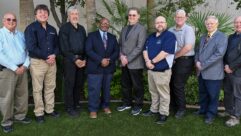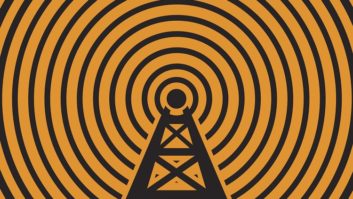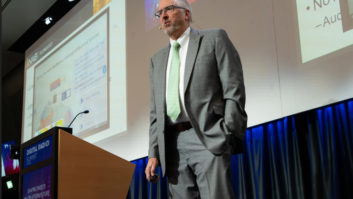LAS VEGAS HD Radio proponents are making an effort to lower conversion costs for stations in medium and smaller markets. They hope that next-generation, lower-cost exporters expected to ship this year, combined with other incentives, will encourage more broadcasters to convert to the technology.
That was one of the themes for digital radio at the NAB Show. Meanwhile, the elevated power level debate dominated many engineering discussions, while Ibiquity Digital also showed off HD Radio-equipped mobile devices that are coming into the market.
Here are highlights of digital radio news at the convention.
Elevated Power Level Is Intense Topic
How to implement elevated FM transmission power levels is a significant issue for radio engineers.
NAB had not filed a proposal with the commission as of early May. Several sources expect a request to the FCC soon asking the agency to grant broadcasters permission to increase FM digital power levels by up to 10 dB.
“People are working it,” said a source close to the issue, referring to a possible filing.
Those who favor the optional power increase say it will improve a station’s digital coverage to better match analog and improve receiver reception. Signal strength is an issue for FM IBOC.
Life without such an elevated power increase is causing anxiety and even doubt about the success of HD Radio, several engineers told Radio World during the NAB Show.
An engineer who works for a major broadcast group said his company is disappointed with coverage of the FM digital signal. His company believes the HD Radio rollout “is dead” without the increase, he said.
Once a request is brought to the FCC, broadcast sources anticipate the commission would put it out on Public Notice and invite comments to encourage debate.
Most manufacturers exhibiting transmission equipment said few customers have headroom in their transmitters to go up the full 10 dB, but that even a 2 or 3 dB increase would provide a noticeable benefit in signal strength and coverage.
The elevated power issue appears to be reaching a critical point. IC manufacturers are readying updated IBOC receiver chips to be available to receiver makers for portables this fall.
Antennas in mobile/portable receivers usually are small and the resulting signal relatively weak. Boosting power level for FM IBOC will help those devices bring in a more robust signal, proponents believe.
To that end, Ibiquity is working on antenna optimizations for portables, President/CEO Bob Struble and company engineers said.
Struble said in an interview he believes the higher power level will be approved, possibly with more experimental licenses first in addition to those already approved for testing.
Boost Would Help Building Penetration
A boost in FM IBOC power level will improve building penetration. That’s the conclusion of Glynn Walden.
Original IBOC power levels were set conservatively to make sure interference to neighbors was almost non-existent, said Walden, one of the technology’s original developers, now an engineering executive with CBS Radio.
Elevated FM IBOC power levels have been tested on stations of several groups, including CBS. He presented a paper showing test results of receiver performance inside buildings when FM IBOC power levels are raised.
He echoed the importance of increasing power levels, citing the inferior quality of most antennas in personal devices.
CBS has been operating with elevated power levels at KROQ(FM), Los Angeles for over a year. The Class B station has an ERP of about 56 watts of digital carrier power, he said.
The team identified 10 buildings of various construction types — from residential to office buildings — for the tests. Measurements were made with the IBOC sidebands at –20 dB and –10 dB. The CBS team, including Regional Engineer Scott Mason, used a Harris Z16HD+ for the tests.
In many locations it was not possible to receive a digital signal when the station was operating at the –20 dB level, he said.
In one building, a receiver near a second-floor window produced good reception at –20 dB, but when it was moved 30 feet into the core of the building, the receiver showed no analog or digital reception.
When the team increased digital power, the receiver delivered good digital reception even 30 feet into the building.
“As we look at the power increase [issue], it’s time for broadcasters to start living in the digital world and leave the analog world behind,” Walden concluded.
Manufacturers of personal devices like mobile phones won’t be interested in adding analog media to digital devices, he said.
Receiver Testing Is Key to Power Debate
John Kean said the more measurements the industry collects, the more it will know about how the next generation of HD-R receivers will behave.
NPR Labs is testing consumer radios and conducting field measurements of mobile and indoor reception, and Kean said it will continue to do so.
At present, he said, NPR Labs’ coverage prediction model is providing remarkably accurate predictions of IBOC digital radio coverage, based on thousands of miles of drive-test data as well as indoor testing.
In a draft report to CPB, Kean predicted little near-term improvement in HD-R receiver performance and said performance actually may decrease thanks to pressure on designs due to price competition.
The lab has completed a series of major studies related to coverage and is working on studies of the impact of IBOC on FM translators, using prediction models of field strength from first-, second- and third-adjacent channels.
This information will be helpful as the industry debates elevated FM IBOC power, he said.
With higher power comes the potential for increased interference to adjacent stations, he noted. This includes the effect higher digital power would have on FM subcarriers, something the International Association of Audio Information Services will look at soon, Kean said.
Radio World will have more on Kean’s work next issue.
Efforts to Lower Conversion Costs Bear Fruit
In what participants call an unprecedented effort, NAB, Ibiquity Digital and four transmission manufacturers developed a lower-cost way to implement the technology.
NAB spent more than $1 million in a two-year effort to lower conversion costs for mid- and small-market stations.
The result is an “embedded exporter,” one that is DSP- rather than PC-based. The result is a more reliable, smaller and less expensive unit, the manufacturers say.
Broadcast Electronics, Continental, Harris and Nautel each developed next-generation HD Radio exporters and were taking orders. The representatives said the devices, to be available later this year, would work with any manufacturer’s transmitter.
The word “embedded” refers to Ibiquity intellectual property in each unit.
Each exporter can be upgraded via USB rather than a CD drive.
The manufacturers said at a press conference the effort resulted in a savings of some $10,000 off a digital system for a typical FM conversion package, which up until now, we’re reported, can range from approximately $75,000 to $150,000 depending on several factors.
The overall $10,000 discount for every station (NAB member and non-member alike) will fluctuate between manufacturers. Some might be $10,000, others might be more or less. NAB believes that the NAB-member discount will account for about $1,500 of the overall reduction.
“It’s cheaper, better and will allow more people to convert,” Struble said in an interview.
The NAB HD Radio Technology Task Force oversaw the effort. Steve Newberry, vice chair of the NAB Radio Board and president/CEO of Commonwealth Broadcasting, said the group decided to work with manufacturers and Ibiquity to develop a more cost-effective version. The exporter is the second-most expensive piece of equipment in the IBOC air chain after the exciter, officials said.
One small-market broadcaster in the audience at the press conference said stations had been waiting for such an announcement, though there were no conversion announcements from small-market broadcasters citing the initiative immediately after the show.
License Incentives, Financing Available
Engineers and others at the convention told RW that a more affordable exporter alone will probably not spur stations with tight finances to convert to HD-R. However, taken with other incentives, it may do the trick.
To that end, Ibiquity is offering broadcasters a licensing incentive through June 30. License any number of stations by that date and the Dec. 31 conversion deadline is waived.
The main channel audio fee for each station is $15,000 through June 30. After June 30, the price of a license for a main HD-R channel increases to $25,000.
Financing also is now available for the Ibiquity broadcaster license fee from National City Media Finance. According to its flyer, monthly payment options are available for between 12 months to 60 months to include transmitters and “other station technology and other related costs” related to a conversion.
Ibiquity Booth Packs Products In
Ibiquity exhibited at the NAB Show, after not having a booth last year, when it opted to for an event sponsorship.
Sources said the company felt there’s so much going on with HD-R products, it needed a dedicated presence on the show floor.
Broadcasters could see many of the receivers that had been displayed in Ibiquity’s booth at CES this winter, such as the football-shaped “iLuv” by LG.
Some 60 products were on display.
Demos of advanced applications included portable IBOC receivers, MSN Direct and conditional access.
Featured automotive products from Alpine, Dual and JVC featured iTunes tagging.
Similarly, iTunes tagging-equipped receivers from JBL, Polk and Sony were on display.
Warren: Teach Consumers to Ask for HD-R
Stations transmitting digital signals have a major role in reaching out to consumers about HD Radio, Diane Warren told engineers.
“It’s our job to get consumers to buy HD Radio. It’s our hope that it won’t take too long before HD Radio is in all radios,” the HD Digital Radio Alliance executive vice president told attendees in a keynote to the Broadcast Engineering Conference.
Noting that the alliance is in its third year, Warren said, “We hope that we’ve made some progress” in the rollout. “We’ve got a lot of work still to do.”
Some 70 million radios are sold in the U.S. each year, she said. More than 6 million are aftermarket radios and the alliance is working to make sure these devices have HD Radio capability.
In the auto world, some 18 million new cars are sold in the country each year, she continued. The alliance has commitments from 13 automakers to place HD-R in a total of 69 models.
Since CE retailers do not have “radio departments” per se, she said, “We need to teach consumers to ask for HD Radio.” That includes making sure content on multicast channels is compelling, and preparing data for iTunes tagging.
An attendee noted a Best Buy video that helps retailers in the DTV transition and asked if similar aid is available for radio. Warren didn’t address the possibility of a retailer training video but said radio needs “to continue to push and move it,” referring to HD Radio.
IBOC Standard Revised
The National Radio Systems Committee adopted an updated version of its IBOC standard, approving NRSC-5-B. The standard most recently had been updated in 2005.
The Digital Radio Broadcasting Subcommittee, co-chaired by Andy Laird, vice president and chief technology officer of the Journal Broadcast Group, and Mike Bergman, vice president for new digital technology at Kenwood USA, adopted the changes.
The most important tweak is the incorporation of a new FM mask that Ibiquity submitted to the FCC in July 2006. The change, adding a “gentle skirt” to the bottom of the mask at the edge of the digital sidebands, will make it easier for manufacturers to comply and offer cost-effective transmission equipment.
The change does not affect audio quality, Bergman said in an interview.
Another change allows an extra two frequency partitions to be used in extended hybrid mode. This brings the potential for FM IBOC up to a full 150 kpbs, according to Bergman.
The group also updated its citations of the Ibiquity reference documents because some of these have been updated. The overarching goal is to make the document easier to read and more consistent “terminology-wise,” sources said, especially concerning language regarding advanced data applications such as program-associated data.
The document will be available to the public through the NRSC Web site following a final procedural review.
Wilson Calls for Dramatic Changes to Radio
CEA’s Dave Wilson predicts a dim future for analog radio and says the medium must go digital.
Mass media, once limited to radio, TV and print, now share the advertising pie with cable, the Internet and satellite radio, among others, he said.
“The pie is larger but radio’s share is smaller. Local radio needs to grow its share of the pie,” he said.
In a recent study, the Consumer Electronics Association asked respondents what CE gift they would most like to receive. Most said an MP3 player; nobody said they wanted an AM/FM tuner or clock radio, he said.
Radio is becoming irrelevant and must find a way to reinvent itself and think beyond getting tuners in all portable audio devices, he says.
Radio needs to become a service provider for portable media players so listeners can customize what they want to hear on their device.
In a session during the Broadcast Engineering Conference, Wilson said radio’s current, inefficient frequency allocation would need to be re-worked to permit such customization. He said the industry should collocate channels and use single-frequency networks to make more efficient use of spectrum.
He expects resistance from the FCC and broadcasters about such a frequency re-allocation, but said radio needs to adapt to changing times to survive.
Although he has worked as an engineer for NAB and now CEA, Wilson also now is a broadcast owner. He has two Class A FMs in Buxton, N.C. He won his frequencies in Auction 37 last year and asked the FCC to approve them as all-digital frequencies but was turned down, he said.
Though it’s unlikely the radio spectrum will be re-allocated, Wilson raised valid points about radio’s future, said one observer.
An NAB spokesman said the frequency re-packing idea “is interesting and thought provoking, but not realistic in today’s world.”











